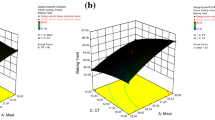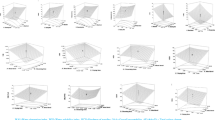Abstract
Meat is considered to be an excellent source of protein, essential minerals, trace elements and vitamins but negative concerns regarding meat consumption and its impact on human health have promoted research into development of novel functional meat products. In the present study Rice bran oil (RBO), and Flaxseed oil (FSO) were used for attaining an ideal lipid profile in the product. The experiment was designed to optimise the RBO and FSO concentration for development of product with ideal lipid profile and maximum acceptability by the application of central composite rotatable design of Response surface methodology (RSM). Levels of RBO and FSO were taken as independent variables and overall acceptability (OAA), n-6 and n-3 fatty acids as responses. Quadratic fit model was found to be suitable for optimising the product. Sample with RBO (20.51 ml) and FSO (2.57 ml) yielded an OAA score of 8.25, 29.54 % of n-6 and 7.70 % of n-3 having n-6/n-3 ratio as 3.8:1. Optimised product was analysed for physico-chemical, sensory and microbial profile during storage at 4 ± 1 °C for 30 days. Increase in the lipid oxidative parameters was observed during storage but it was not significant (p < 0.05). Studies revealed great potential of developing functional poultry products with improved nutritional quality and good shelf stability by incorporating RBO and FSO.





Similar content being viewed by others

References
(http://www.foodauthority.nsw.gov.au/_Documents/science/microbiological_quality_guide_for_RTE_food.pdf, July 2009)
Alós E, Cercós M, Rodrigo MJ, Zacarías L, Talón M (2006) Regulation of color break in citrus fruits. Changes in pigment profiling and gene expression induced by gibberellins and nitrate, two ripening retardants. J Agri food chem 54(13):4888–4895
Ansorena D, Astiasaran I (2004) The use of linseed oil improves nutritional quality of the lipid fraction of dry-fermented sausages. Food Chem 87(1):69–74
AOAC (2000) Official methods of analysis. Association of Official Analytical Chemists, Arlington
AOCS (1993) American oil Chemists society official method. Free Fatty Acid, Champaign
APHA (1992) In: Speck ML (ed.) compendium of methods for the microbiological examination of foods, 16th ed. American public health association, Washington
Barton L, Marounek M, Kudrna V, Bures D, Zahradkova R (2007) Growth performance and fatty acid profiles of intramuscular and subcutaneous fat from Limousin and Charolais heifers fed extruded linseed. Meat Sci 76(3):517–523
Bastos SC, Pimenta M, Pimenta C, Reis T, Nunes C, Pinheiro AC, Fabrício LF, Leal RS (2014) Alternative fat substitutes for beef burger: technological and sensory characteristics. J Food Sci Technol 51(9):2046–2053
Fernández‐Ginés JM, Fernández‐López J, Sayas‐Barberá E, Pérez‐Alvarez J (2005) Meat products as functional foods: a review. J Food Sci Technol 70(2):R37–R43
Gebauer SK, Psota TL, Harris WS, Kris-Etherton PM (2006) n−3 fatty acid dietary recommendations and food sources to achieve essentiality and cardiovascular benefits. Am J Clin Nut 83(6):S1526–1535S
Gray JI, Gomaa EA, Buckley DJ (1996) Oxidative quality and shelf life of meats. Meat Sci 43:111–123
Jalarama Reddy K, Jayathilakan K, Pandey MC, Radhakrishna K (2013a) Evaluation of the physico-chemical stability of rice bran oil and its blends for the development of functional meat products. Int J Food Nutr Sci 2(2):46–53
Jalarama Reddy K, Pandey MC, Harilal PT, Radhakrishna K (2013b) Optimization and quality evaluation of freeze dried mutton Manchurian. Int J Food Res 20(6):3101–3106
Juárez M, Dugan ME, Aalhus JL, Aldai N, Basarab JA, Baron VS, McAllister TA (2011) Effects of vitamin E and flaxseed on rumen-derived fatty acid intermediates in beef intramuscular fat. Meat Sci 88(3):434–440
Madamba PS (2002) The response surface methodology: an application to optimize dehydration operations of selected agricultural crops. Lebensittel Wiss Technol 35:584–592
Mantzioris E, James MJ, Gibson RA, Cleland LG (1994) Dietary substitution with an alpha-linolenic acid-rich vegetable oil increases eicosapentaenoic acid concentrations in tissues. Am J Clin Nutr 59(6):1304–1309
Mercier Y, Gatellier P, Renerre M (2004) Lipid and protein oxidation in vitro, and antioxidant potential in meat from Charolais cows finished on pasture or mixed diet. Meat Sci 66(2):467–473
Metcalf LD, Schmitz AA, Pelka JR (1966) Rapid preparation of fatty acid esters from lipids for gas chromatographic analysis. Anal Chem 38:514–515
Muguerza E, Ansorena D, Astiasarán I (2004a) Functional dry fermented sausages manufactured with high levels of n‐3 fatty acids: nutritional benefits and evaluation of oxidation. J Sci Food Agric 84(9):1061–1068
Muguerza E, Gimeno O, Ansorena D, Astiasaran I (2004b) New formulations for healthier dry fermented sausages: a review. Trends Food Sci Technol 15(9):452–457
Murray JM, Delahunty CM, Baxter IA (2001) Descriptive sensory analysis—past, present, future. Food Res Int 34:461–471
Myers RH, Montegomery DC (2002) A text book of “Response surface methodology: process and product optimization using design experiments, 2nd edn. Wley, USA, pp 321–342
Orellana C, Peña F, García A, Perea J, Martos J, Domenech V, Acero R (2009) Carcass characteristics, fatty acid composition, and meat quality of Criollo Argentino and Braford steers raised on forage in a semi-tropical region of Argentina. Meat Sci 81(1):57–64
Orthoefer FT (2005) Rice bran oil. Bailey’s industrial oil and fat products. 2 (6 ed.). Wiley. 2005: p. 465
Pelser WM, Linssen JPH, Legger A, Houben JH (2007) Lipid oxidation in n−3 fatty acid enriched Dutch style fermented sausages. Meat Sci 75(1):1–11
Raes K, De Smet S, Demeyer D (2004) Effect of dietary fatty acids on incorporation of long chain polyunsaturated fatty acids and conjugated linoleic acid in lamb, beef and pork meat: a review. Anim Feed Sci Technol 113(1):199–221
Shand PJ (2000) Textural, water holding and sensory properties of low-fat pork bologna with normal or waxy starch hull less barley. J Food Sci 65:101–107
Siger A, Nogala‐Kalucka M, Lampart‐Szczapa E (2008) The content and antioxidant activity of phenolic compounds in cold‐pressed plant oils. J Food Lip 15(2):137–149
Sin HN, Yusof S, Sheikh Abdul HN, Abdul Rahman R (2006) Optimization of hot water extraction for sapodilla juice using response surface methodology. J Food Eng 74:352–358
Taraldgis BG, Watts BM, Younathan MT, Dugan LG (1960) A distillation method for quantitative determination of malonaldehyde in rancid foods. J Am Oil Chet Soc 37:44–48
Vaisey-Genser M, Morris DH (2003) Introduction: history of the cultivation and uses of flaxseed. Linum 1:21
Valencia I, Ansorena D, Astiasaran I (2006) Nutritional and sensory properties of dry fermented sausages enriched with n−3 PUFAs. Meat Sci 72(4):727–733
Yadav DN, Sharma GK, Bawa AS (2007) Optimization of soy-fortified instant sooji halwa mix using response surface methodology. J Food Sci Technol 44(3):297–300
Yalçın H, Unal MK (2010) The enrichment of hen eggs with ω-3 fatty acids. J Med Food 13(3):610–614
Yogesh K, Ahmad T, Manpreet G, Mangesh K, Das P (2013) Characteristics of chicken nuggets as affected by added fat and variable salt contents. J Food Sci Technol 50(1):191–196
Yogesh K, Langoo BA, Sharma SK, Yadav DN (2015) Technological, physico-chemical and sensory properties of raw and cooked meat batter incorporated with various levels of cold milled flaxseed powder. J Food Sci Technol 52(3):1610–1617
Conflicts of interest
The authors report no conflicts of interest. The authors alone are responsible for the content and writing the article.
Author information
Authors and Affiliations
Corresponding author
Rights and permissions
About this article
Cite this article
Reddy, K.J., Jayathilakan, K. & Pandey, M.C. Development of designer chicken shred with response surface methodology and evaluation of its quality characteristics. J Food Sci Technol 53, 471–480 (2016). https://doi.org/10.1007/s13197-015-1995-9
Revised:
Accepted:
Published:
Issue Date:
DOI: https://doi.org/10.1007/s13197-015-1995-9



